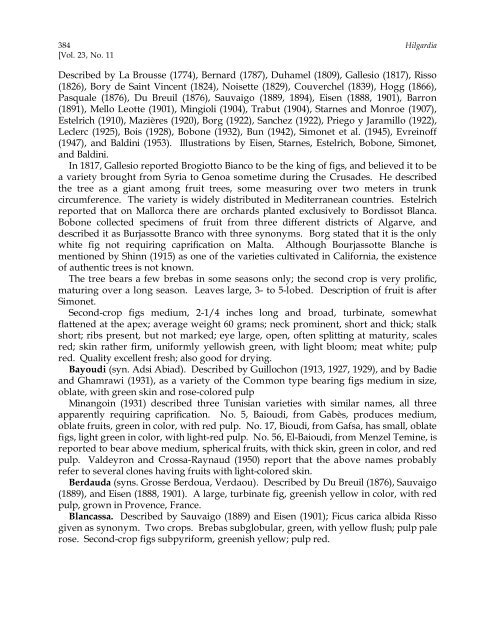Fig Varieties: A Monograph - uri=ucce.ucdavis
Fig Varieties: A Monograph - uri=ucce.ucdavis
Fig Varieties: A Monograph - uri=ucce.ucdavis
Create successful ePaper yourself
Turn your PDF publications into a flip-book with our unique Google optimized e-Paper software.
384 Hilgardia<br />
[Vol. 23, No. 11<br />
Described by La Brousse (1774), Bernard (1787), Duhamel (1809), Gallesio (1817), Risso<br />
(1826), Bory de Saint Vincent (1824), Noisette (1829), Couverchel (1839), Hogg (1866),<br />
Pasquale (1876), Du Breuil (1876), Sauvaigo (1889, 1894), Eisen (1888, 1901), Barron<br />
(1891), Mello Leotte (1901), Mingioli (1904), Trabut (1904), Starnes and Monroe (1907),<br />
Estelrich (1910), Mazières (1920), Borg (1922), Sanchez (1922), Priego y Jaramillo (1922),<br />
Leclerc (1925), Bois (1928), Bobone (1932), Bun (1942), Simonet et al. (1945), Evreinoff<br />
(1947), and Baldini (1953). Illustrations by Eisen, Starnes, Estelrich, Bobone, Simonet,<br />
and Baldini.<br />
In 1817, Gallesio reported Brogiotto Bianco to be the king of figs, and believed it to be<br />
a variety brought from Syria to Genoa sometime during the Crusades. He described<br />
the tree as a giant among fruit trees, some measuring over two meters in trunk<br />
circumference. The variety is widely distributed in Mediterranean countries. Estelrich<br />
reported that on Mallorca there are orchards planted exclusively to Bordissot Blanca.<br />
Bobone collected specimens of fruit from three different districts of Algarve, and<br />
described it as Burjassotte Branco with three synonyms. Borg stated that it is the only<br />
white fig not requiring caprification on Malta. Although Bourjassotte Blanche is<br />
mentioned by Shinn (1915) as one of the varieties cultivated in California, the existence<br />
of authentic trees is not known.<br />
The tree bears a few brebas in some seasons only; the second crop is very prolific,<br />
maturing over a long season. Leaves large, 3- to 5-lobed. Description of fruit is after<br />
Simonet.<br />
Second-crop figs medium, 2-1/4 inches long and broad, turbinate, somewhat<br />
flattened at the apex; average weight 60 grams; neck prominent, short and thick; stalk<br />
short; ribs present, but not marked; eye large, open, often splitting at maturity, scales<br />
red; skin rather firm, uniformly yellowish green, with light bloom; meat white; pulp<br />
red. Quality excellent fresh; also good for drying.<br />
Bayoudi (syn. Adsi Abiad). Described by Guillochon (1913, 1927, 1929), and by Badie<br />
and Ghamrawi (1931), as a variety of the Common type bearing figs medium in size,<br />
oblate, with green skin and rose-colored pulp<br />
Minangoin (1931) described three Tunisian varieties with similar names, all three<br />
apparently requiring caprification. No. 5, Baioudi, from Gabès, produces medium,<br />
oblate fruits, green in color, with red pulp. No. 17, Bioudi, from Gafsa, has small, oblate<br />
figs, light green in color, with light-red pulp. No. 56, El-Baioudi, from Menzel Temine, is<br />
reported to bear above medium, spherical fruits, with thick skin, green in color, and red<br />
pulp. Valdeyron and Crossa-Raynaud (1950) report that the above names probably<br />
refer to several clones having fruits with light-colored skin.<br />
Berdauda (syns. Grosse Berdoua, Verdaou). Described by Du Breuil (1876), Sauvaigo<br />
(1889), and Eisen (1888, 1901). A large, turbinate fig, greenish yellow in color, with red<br />
pulp, grown in Provence, France.<br />
Blancassa. Described by Sauvaigo (1889) and Eisen (1901); Ficus carica albida Risso<br />
given as synonym. Two crops. Brebas subglobular, green, with yellow flush; pulp pale<br />
rose. Second-crop figs subpyriform, greenish yellow; pulp red.
















![Fig Trees in North Carolina [Archive] - IDigMyGarden ... - Figs 4 Fun](https://img.yumpu.com/26905320/1/190x245/fig-trees-in-north-carolina-archive-idigmygarden-figs-4-fun.jpg?quality=85)